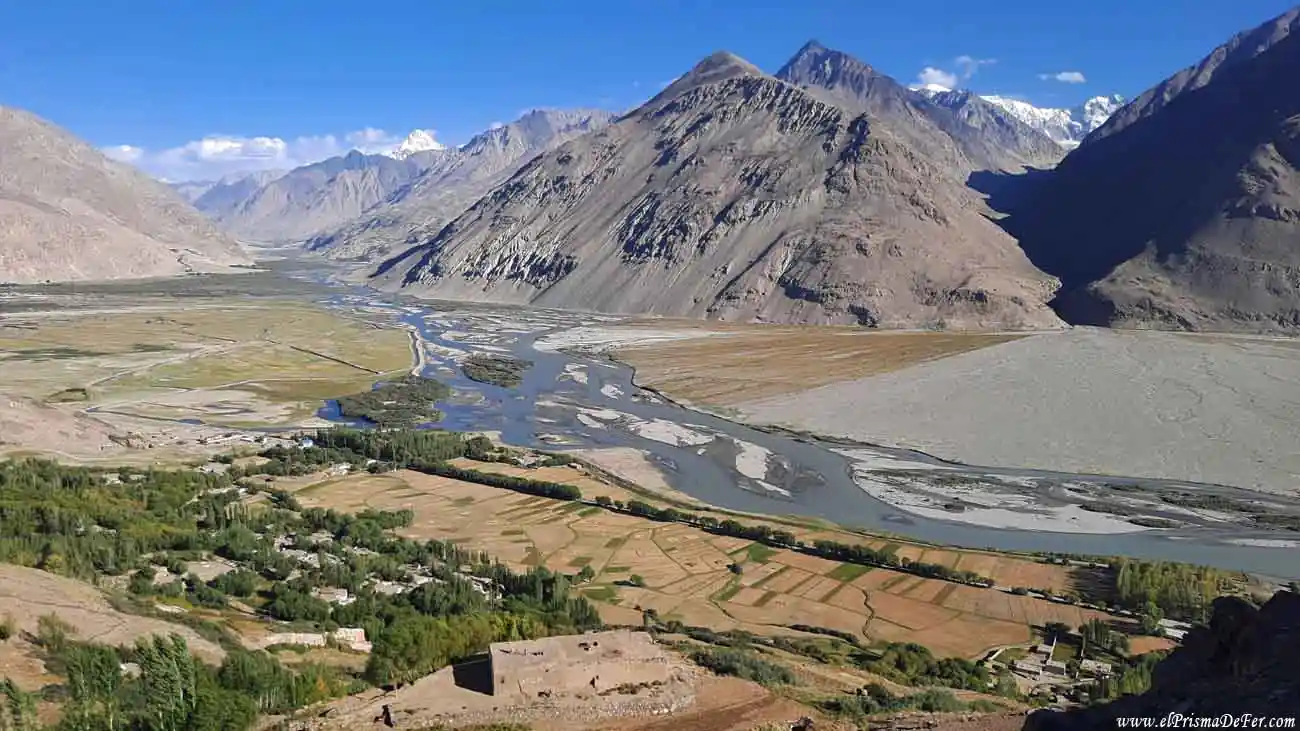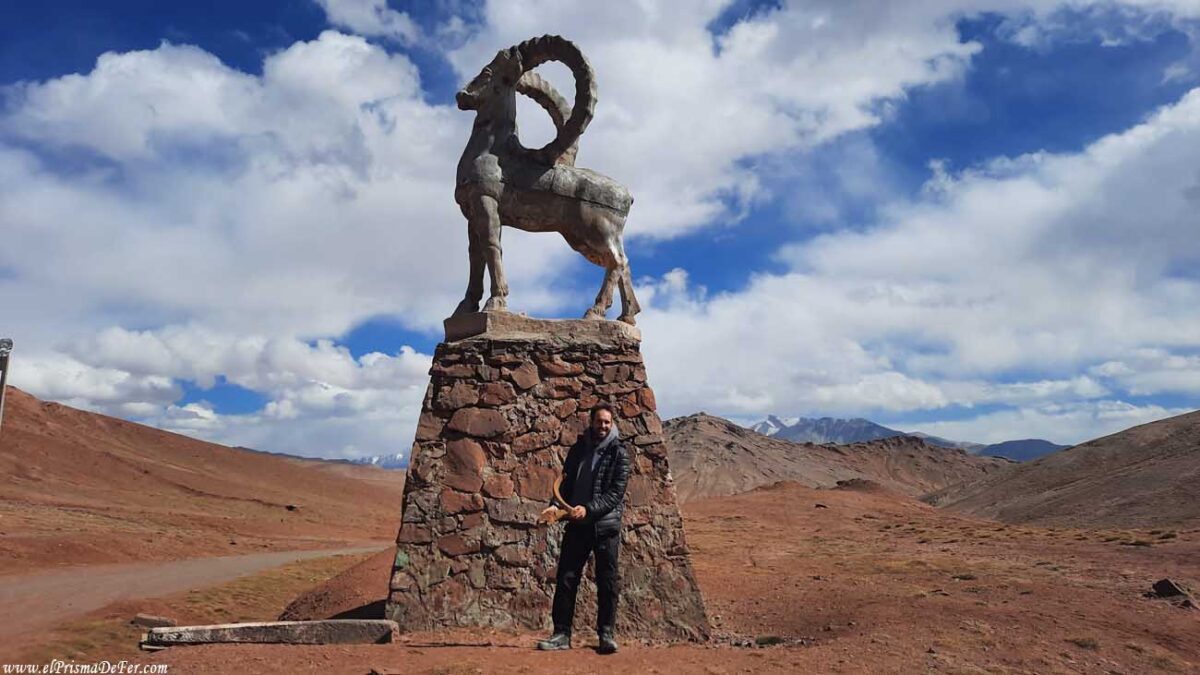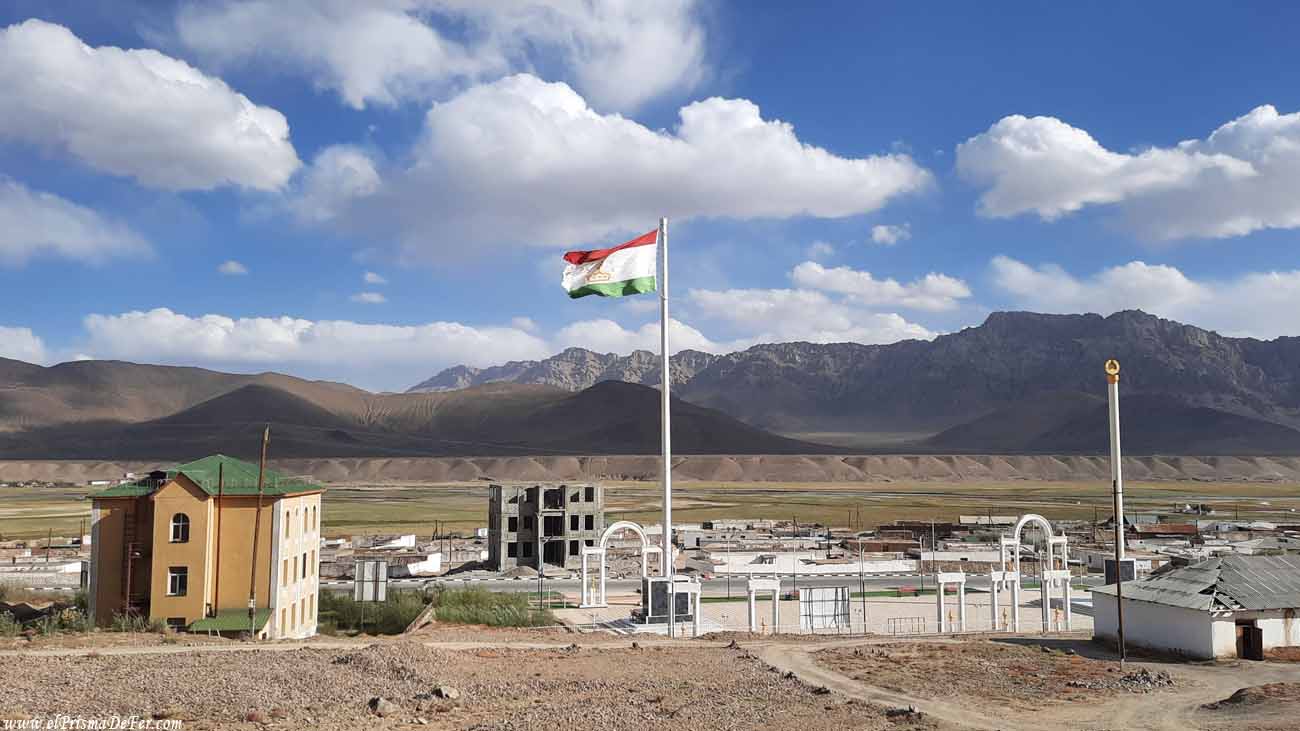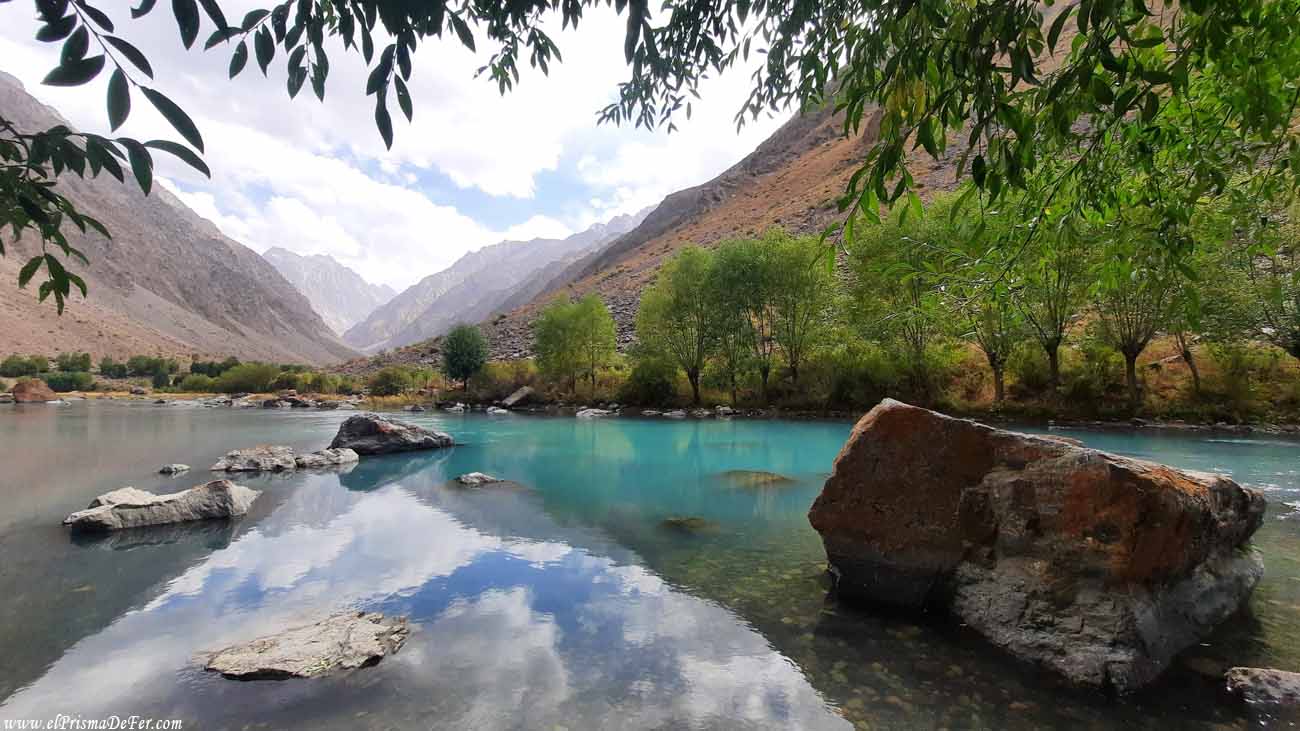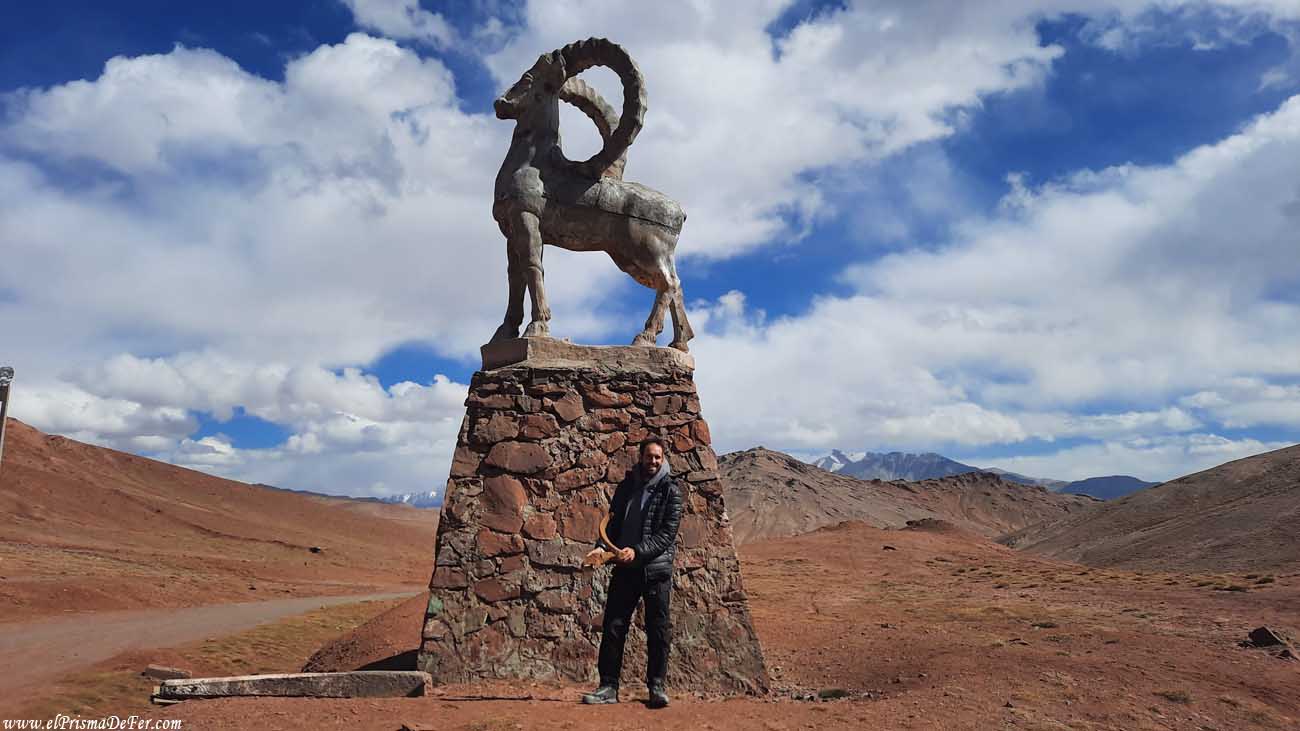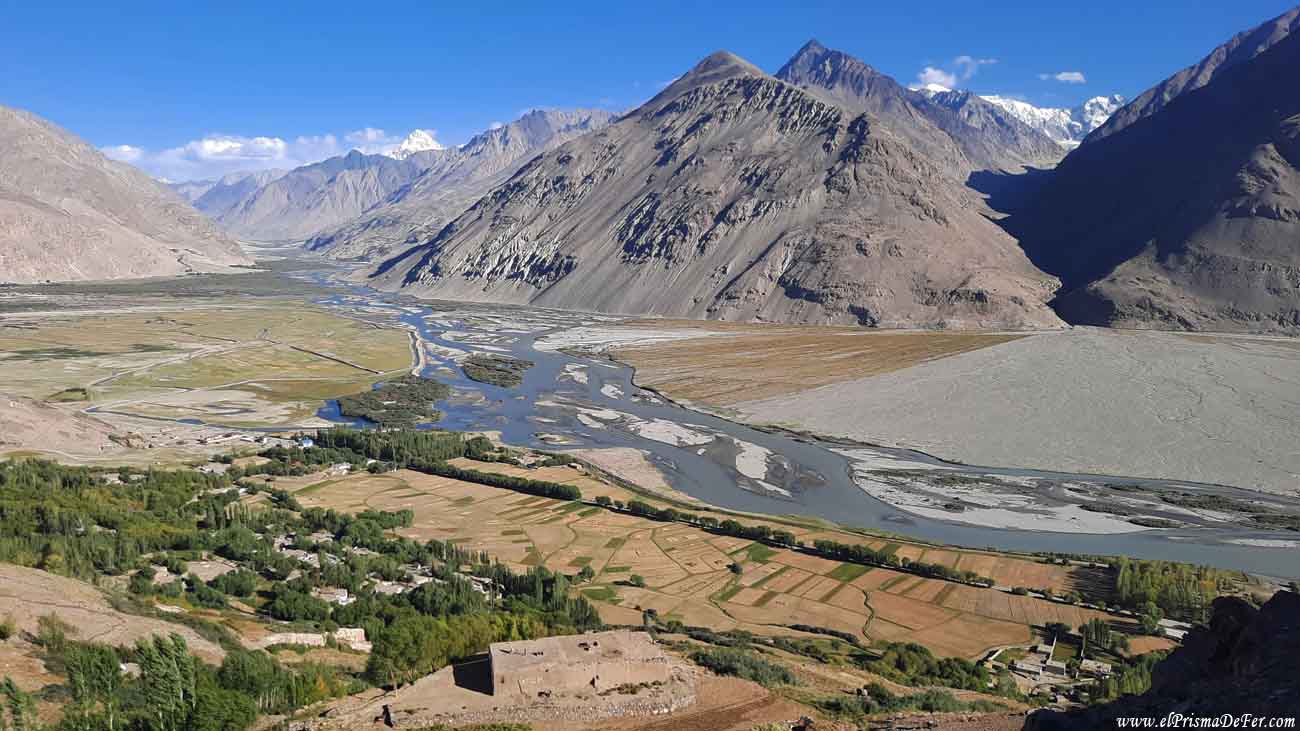Traveling through Tajikistan is like entering a world of endless mountains, difficult roads, and villages hidden among the valleys. Especially in the Pamir region, I felt like I was in the most remote place I've ever been. The feeling of isolation is total: few services, few connections, and an overwhelming desolation surrounded by mountains that make you feel small. But at the same time, this disconnection is what makes this part so special.
When I was still in Kyrgyzstan, my mind wandered back and forth to this part of the planet. Traveling through Tajikistan, especially the Pamir region, on my own, was a source of uncertainty. Little-known, mountainous, underdeveloped, and bordered by isolated borders, it didn't seem like the easiest destination.
Luckily, everything went well, I was able to move at my own pace, without hiring tours, and today I can say that it was, without a doubt, the country where I found the kindest and most hospitable people in the entire region.
In this guide to traveling through Tajikistan, and in another where I will tell you about my experience traveling through the Pamirs independently, I tell you how to get around, what to see, and why this country is a hidden gem worth exploring, especially if you are looking for adventure, desolation, and contact with the friendliest people in Central Asia.

Table of Contents
What to know before traveling to Tajikistan
| Language 🗣️ |
| The official language is Tajik, a language related to Persian (Farsi). Russian is also widely used, especially in formal settings or among older people. English is rarely spoken. In the mountainous regions, there are communities that maintain their own ancestral languages, such as Wakhi. |
| Currency 💵 |
| The local currency is the Tajik somoni (TJS). ATMs and credit cards are not accepted in many parts of the country, so it's important to carry cash, especially if you're traveling in the Pamirs or rural areas. |
| Religión ☪️ |
| The majority of the population is Sunni Muslim, although the practice is generally quite moderate. In more rural or traditional areas, there may be a stronger religious presence, but the atmosphere for travelers is very relaxed and respectful. |
| Ubicación 📍 |
| Tajikistan is located in the heart of Central Asia, surrounded by Uzbekistan, Kyrgyzstan, China, and Afghanistan. It is an extremely mountainous country, with more than 90% of its territory covered by mountain ranges, especially the Pamirs and Alays. |
| Capital 🏙️ |
| Its capital is Dushanbe, a quiet, small city with many modern monuments and buildings. With around 1 million inhabitants, it is the main entry point into the country and the ideal place to organize your trip to the mountainous areas. |
| Visa 🛂 |
| For many countries (including much of Europe and Latin America), visas are not required for short stays of up to 30 days, but it's always a good idea to check the latest regulations. If you're traveling in the Pamirs, you'll need a special authorization called a GBAO Permit, which you can apply for alongside your visa or separately. |

You might be interested in reading about what it's like to travel the Silk Road today, and what path I followed
Map of Tajikistan
📖 A look at the history of Tajikistan
Tajikistan's history is complex, and as a traveler, it's fascinating to see how all that past has left its mark on its people, its culture, and even the architecture that still survives in its towns and cities.
Origins
Tajiks are a people of Iranian/Persian origin, which clearly distinguishes them from their Turkic neighbors (such as Uzbeks or Kazakhs). For centuries, this area was part of great Persian empires, and many caravan routes crossed present-day Tajikistan as part of the Silk Road. In fact, in cities like Penjikent you can see ruins dating back more than 1,000 years, with frescoes reminiscent of Zoroastrian and Buddhist times, before the arrival of Islam.

🕌 Middle Ages
In the Middle Ages, it was invaded by the Arabs and later by the Mongols under Genghis Khan. It would then undergo centuries of regional domination under various khanates and emirates. As early as the 19th century, Tajikistan fell under the control of the Russian Empire, and later, in 1929, was incorporated as a republic within the USSR. During the Soviet era, much of its infrastructure was modernized, but some of its local traditions and identities were also suppressed.

🗓 Independence (1991 – present)
Following the fall of the Soviet Union in 1991, Tajikistan gained its independence, but was almost immediately drawn into a civil war (1992–1997) that left the country severely devastated. Since then, the government has remained stable (albeit authoritarian), and the country has slowly opened up to tourism, particularly in the mountainous regions.
Today, Tajikistan is a destination where history permeates every valley and remote village, from ancient remnants of the Silk Road to old Soviet buildings, to villages that maintain vibrant cultures and ancient traditions.
🧑✈️ Who rules Tajikistan? The omnipresent president
Traveling through Tajikistan isn't just a trip through mountains and remote villages; it's also a political experience in a way. As soon as you arrive, you'll begin to notice that the president's image is everywhere: on billboards, public buildings, plazas, schools, and even tourist brochures.

The current president is Emomali Rahmon, in power since 1992, shortly after independence from the Soviet Union. His government endured the harsh civil war of the 1990s, and has since consolidated a strong leadership, which some describe as authoritarianism or soft dictatorship.
📸 Constant presence
- Rahmon is presented as the “father of the nation” and his figure is strongly associated with order and stability after the civil war.
- His family also holds key positions, and is believed to be paving the way for his son to succeed him.
- On the street, the topic isn't talked about much, and people tend to be very cautious when expressing opinions. As a traveler, it's best to avoid deep political conversations unless you're close enough.
🤐 Limited freedom of expression
- In Tajikistan, the media is tightly controlled, and there are restrictions on opposition parties and NGOs.
- Critical social media and websites are sometimes blocked, but you can access them without any problems with a VPN.
As a tourist, you won't have any problems if you don't try to get involved in political issues. But it's hard not to notice the air of a country "controlled from above," where everything is well taken care of... as long as the official line is maintained.

👥 What are Tajiks like?
One of the things I loved most about Tajikistan was the warmth of its people. There are few places where I've felt so welcomed: Tajiks are kind, hospitable, and curious, always willing to offer you tea, bread, or just a chat even if they don't speak your language. Especially in rural areas, hospitality is part of the culture, and it's not uncommon for people to invite you into their homes without knowing you, just because you're a visitor.

I experienced this firsthand several times. One of them was when I had to wait a couple of hours for a marshrutka to leave Artuch for Panjakent. The driver, without speaking a word of English, took me to his home, introduced me to his family, and they fed me like a pig: plate after plate, nonstop (and none of them spoke English).

Another time, in Darshai (Wakhan Valley), Tino, a German who had picked me up in his camper, and I stopped at a house to ask if they knew where we could stay for the night. The woman didn't hesitate and invited us to stay and eat with them. Although we decided to pay her, it was more out of a completely disinterested attitude than a business relationship.

Different ethnicities
Although the country is often referred to as a single entity, Tajikistan is actually a highly diverse ethnic and cultural mosaic. The majority of the population is ethnic Tajik, of Persian origin, and they speak a variant of Farsi. But within the country there are large regional differences:
- The Pamirs are home to a mix of mountain peoples who speak their own languages (such as Wakhi and Shughnan) and maintain traditions very distinct from the rest of the country. They are more isolated, and their way of life is closely tied to the mountains.
- In the north, especially near Khujand or Istaravshan, more Uzbek and Soviet influences are felt, both in architecture and in language and food.
- There are also Russian, Uzbek, Kyrgyz, and even Chinese minorities in some cities. While many Russian communities emigrated after the fall of the USSR, there are still older residents who grew up under Soviet influence and speak Russian as their native language.
Despite these differences, something common throughout most of the country is pride in their identity, respect for family and customs, and a tranquil, simple, and deeply connected to nature way of life.

💰 Stark contrasts: between Dushanbe and the rest of the country
One of the most striking aspects of traveling through Tajikistan is the stark contrast between Dushanbe and the country's interior. The capital has a modern face: wide avenues, imposing government buildings, illuminated fountains, gleaming statues, and an infrastructure that at first glance seems like it belongs in a much more developed country.

But as soon as you leave Dushanbe, reality changes rapidly. In many villages, especially in rural areas in the north or in the Pamir regions, life is very simple, almost austere. Adobe houses, dirt roads, intermittent electricity, and very limited basic services. The rural economy depends largely on agriculture, barter, and money from emigrated relatives, especially to Russia.
🏙️ Where is the investment?
The general feeling is that the majority of state resources are focused on beautifying the capital, where a small portion of the population lives. Meanwhile, in the rest of the country, basic infrastructure, health, and education remain significant challenges.
It's a bit jarring to see that contrast, especially when you go from crossing a remote Pamir valley where access to clean water or internet is a luxury to walking along the tree-lined boulevards of Dushanbe.
🌍 What language do they speak in Tajikistan?
The official language is Tajik, a language related to Persian (Farsi), so those who have traveled through Iran or Afghanistan will notice similarities. Russian is also widely used, especially in formal settings or among older people, particularly in cities. English is rarely spoken, except in some tourist accommodations or in Dushanbe, so bringing an offline translator or learning some basic phrases can be very helpful.
Furthermore, Tajikistan is a linguistically diverse country. In many mountainous regions, such as the Wakhan Corridor or the Bartang Valley, there are communities that maintain their own ancestral languages, such as Shughnan, Wakhi, or Yagnobi, which are not directly related to Tajik and are part of the Pamir language group. These languages are spoken within families and villages, giving the country enormous cultural richness.

🚙 How to get around Tajikistan
Getting around Tajikistan can be quite an adventure. The distances are not always long in kilometers, but the routes are slow, mountainous, and often in poor condition, especially in remote areas. Here are the main regions and how to get around each one:
🏙️ Dushanbe and surrounding areas
In the capital and its surrounding areas, transportation is relatively easy. There are marshrutkas (shared minivans), taxis, and even city buses. To travel to other cities, minivans and shared cars depart daily from Dushanbe, although not always at fixed times. There are also car rentals with drivers, ideal if you're traveling in a group or want comfort.
🛤️ Route to the north (Khujand, Istaravshan)
To go to the north of the country, you have to cross high mountains on paved roads but with many tunnels and curves.
There are also occasional internal flights between Dushanbe and Khujand, but they are easily cancelled due to bad weather or low demand.
The most common option is to take a shared car from Dushanbe to Khujand (approx. 8–10 hours).
🏞️ Western zone (Penjikent, Iskanderkul, Fann Mountains)
More accessible than the Pamirs, this area is perfect for trekking and nature.
- From Dushanbe to Penjikent there are daily minibuses (6 to 8 hours).
- To get to places like Iskanderkul or the Fann Mountains, there are shared taxis to base villages, like Artuch, and then hikes. Some accommodations offer transfers from the main route.
🏔️ Pamir Region (M41 – Pamir Highway)
This is where the most challenging and incredible part begins. The famous Pamir Highway (M41) connects Dushanbe with Murghab, passing through Khorog and the Wakhan Valley.
- From Dushanbe to Khorog: You can take a shared jeep (they leave from the Dushanbe bus station), but it's a 15-20 hour drive on rough roads.
- From Khorog you can continue your journey to Murghab or the Wakhan Corridor, also in shared or private jeeps.
Many travelers group together in groups of 3 or 4 to rent a 4×4 car with a driver for several days. It's expensive, but it's the best way to explore at a leisurely pace, stopping along the way. There are also forums or guesthouses that help you find someone to share a ride with.
It's also possible to explore it on your own, as I did. It's much more uncertain, but if you do, it's much cheaper.
You can now read the detailed post on how to explore the Pamir Trail on your own.
Visas and permits for travel to Tajikistan
In recent years, Tajikistan has greatly relaxed its visa policy, making it much easier for international travelers to enter the country. Currently, citizens of more than 50 countries (including almost all of Europe, much of Latin America, the United States, Canada, among others) can enter without a visa or with a free e-visa for a period of up to 30 days. It is advisable to check the updated list on the official visa website or on the website of the Ministry of Foreign Affairs of Tajikistan, as it may change.
GBAO Permit
If you plan to visit the spectacular Pamir Mountains (Gorno-Badakhshan Autonomous Oblast), you'll need to apply for a GBAO permit (Gorno-Badakhshan Autonomous Oblast). This permit can be applied for at the same time as an e-visa, or if you're entering without a visa, you can apply for it separately online or directly in Dushanbe.
The GBAO has an additional cost (around 20 USD) and is mandatory to access areas such as Khorog, the Wakhan Corridor, and the Pamir Highway.
Registration for stays of more than 10 days
Another important point: if you plan to stay more than 10 days in Tajikistan, you need to officially register with the local authorities. This can be done at the OVIR (Office of Immigration Registration) in Dushanbe or other major cities, and some guesthouses or travel agencies can help you with the process. If you don't, you may be charged quite expensive fines when you try to leave the country or when you go through checkpoints.
🧭 Fun facts about Tajikistan
Tajikistan is a country full of contrasts, between gigantic mountains, ancient traditions, and remnants of the Soviet past. Here are some facts you might not know that might make your trip more interesting:
🏔️ 1. More than 90% of the country is mountainous!
Tajikistan is one of the most mountainous countries in the world. Much of its territory is occupied by the Pamir and Alay mountain ranges, and many villages are at altitudes of over 2,000 or 3,000 meters. It even has one of the highest peaks in Central Asia: Ismoil Somoni, at 7,495 meters.

🛣️ 2. It has one of the most extreme routes in the world
The Pamir Highway (M41) is the second highest international highway on the planet. It's popular with cyclists, motorcyclists, adventure travelers, and those who love rugged terrain. In some sections, there's no pavement, signs, or services for hundreds of kilometers.
🗣️ 3. Many peoples retain their own languages
In addition to Tajik, there are villages in the Wakhan, Bartang and Yagnob where ancient Iranian languages are still spoken, some with very few speakers. In a single trip, you can hear languages spoken nowhere else in the world.
🧴 4. The strongest perfume you'll ever smell: qurut
Qurut are small balls of fermented dried yogurt that are used in traditional food, especially for qurutob. They have an intense aroma and strong flavor, but are a key part of the local culinary identity.
🎉 5. Weddings last several days
As in many countries in the region, weddings in Tajikistan can last 3 or 4 days, with different rituals, dances, banquets, and traditional clothing.
🇹🇯 6. It was, and remains, the poorest country after the fall of the USSR
After gaining independence in 1991, Tajikistan experienced a devastated civil war between 1992 and 1997. It's only in recent years that it has begun to stabilize and attract travelers. Therefore, traveling here also means supporting a resilient and hospitable population.


🏔️ Must see places to visit in Tajikistan
Tajikistan is a country for those who love mountains, wild nature, and off-the-beaten-track trails. Although it's often off the tourist radar, it boasts unique places that make you feel like you're in another world. These are some of the places you shouldn't miss on your itinerary:
🛣️ The Pamirs and the Pamir Highway (M41)

This is Tajikistan's big draw. The Pamir Highway is one of the highest and most spectacular routes in the world, crossing lunar landscapes, remote villages, and passes over 4,000 meters high.
- The most popular route is between Dushanbe and Osh (Kyrgyzstan) or vice versa, passing through Khorog, the Wakhan Valley, Langar, Murghab and other unforgettable places.
- The Wakhan is especially fascinating: immense mountains, the Panj River marking the border with Afghanistan, and villages where time seems to stand still.
You can travel by shared 4x4, by bike, or even by hitchhiking. The important thing is to take the time to enjoy the trip.
🏙️ Dushanbe, the capital

Tajikistan's capital isn't huge or chaotic, which makes it travel-friendly. There are museums, markets, cafes, and wide, tree-lined boulevards for leisurely strolls.
The National Museum of Tajikistan, the gigantic monumental flag, and the modern Central Mosque are some of its attractions.
It is also a good starting point for organizing trips to the Pamirs or the north of the country.
🌄 Fann Mountains and Penjikent

A little-known gem that's much more accessible than the Pamirs. The Fann Mountains offer crystal-clear lakes, trekking trails, and homestay villages. Places like Iskanderkul, Lake Alaudin or Kulikalon are true postcards. Ideal for those who want to trek without going as far or as high as the Pamirs.
From the city of Penjikent, you can easily access these mountains, as well as visit the archaeological ruins of the ancient Sogdian city, a witness to the passage of the Silk Road.
🕌 Khujand

The country's second largest city, with a rich history dating back to Alexander the Great, who founded the ancient “Alexandria Eschate” here. Today, it blends Soviet architecture with traditional bazaars, a reconstructed citadel, and the Syr Darya River area, which offers pleasant walks.
It is also an excellent stopover if you are entering or leaving from Uzbekistan.
📌 Other places you can add:
- Iskanderkul: a glacial lake with turquoise waters surrounded by mountains, just a few hours from Dushanbe.
- Bartang Valley: remote and wild, ideal for those looking for less-traveled routes.
- Istaravshan: another historic city with an interesting mix of Persian and Soviet culture.

🍽 Typical food of Tajikistan
🥘 Plov
The typical dish of Central Asia. It consists of rice cooked with carrots, onions, and meat (usually lamb), all prepared in a large cauldron. It's very common at family gatherings and celebrations.

🍲 Qurutob
Probably the most Tajik dish of all. It's made with crumbled bread dipped in a sauce made with qurut (dried balls of sour yogurt), fried onions, and sometimes tomato or herbs. It's eaten with the hands.
🥟 Manti
Large steamed ravioli, filled with meat or potato, similar to those found throughout Central Asia.

🥩 Shashlik
Grilled meat skewers, very common in markets and restaurants. They can be made with lamb, beef, chicken, or liver, and are usually accompanied by bread and raw onions.

Sambusa
Small empanadas filled with meat, potato, or pumpkin, baked or fried. A good quick option for eating on the go.
Lagman
Thick noodles with meat and vegetables, served in soup or stir-fried. It's influenced by Uyghur cuisine and is ideal for cold days.

🌍 Tajikistan and its borders with neighboring countries
Tajikistan is a country surrounded by mountains and complex borders, and on several of them there have been, and still are, intermittent tensions or conflicts, especially with some of its neighbors. While this doesn't usually directly affect travelers, it's important to be informed, especially if you plan to cross land borders.
🇰🇬 Conflicts with Kyrgyzstan
The most conflict-ridden area is the border with Kyrgyzstan, especially in the Fergana Valley, where the borders are a veritable puzzle inherited from the Soviet era. There are enclaves and villages of one ethnic group surrounded by the territory of the other, which has generated clashes over access to water, agricultural land, and roads.
In 2021 and 2022, there were serious armed clashes between the two countries, resulting in casualties and displacement. Although these clashes generally occur in specific, rural areas (such as the Batken region in Kyrgyzstan), tensions remain simmering.

Travel advice: Avoid crossing through secondary border crossings between Tajikistan and Kyrgyzstan if they are near the Fergana Valley. The most used and safest crossing is the one from Osh to Murghab, part of the Pamir Trail, or from Osh, crossing through Uzbekistan to Khudzhand.
🇺🇿 Border with Uzbekistan
For years, the border between Tajikistan and Uzbekistan was closed or restricted, especially under the previous Uzbek government. Since 2018, with the change of leadership in Uzbekistan, relations have improved significantly , and border crossings have reopened. Today, it is easy to cross without any major problems and is a popular option for backpackers.
🇦🇫 Border with Afghanistan
Tajikistan shares a long, mountainous border with Afghanistan, separated by the Panj River. Most travelers travel through this area along the Wakhan Corridor, where the river acts as a natural boundary.
While there is no crossing into Afghanistan from here, it is a quiet and safe area from the Tajik side. A few years ago, this border was closed, and it was not possible to legally cross to the Afghan side, but when I was there (2024) there were already several border crossings open.
I've spoken to several backpackers who were headed there, having previously obtained visas. In short, it's still safe to travel near the border within the classic Pamir itinerary.
🇨🇳 Border with China
Tajikistan shares a long and remote eastern border with China, which runs through the highlands of the Pamirs. Although there have been historical territorial tensions (resolved in 2011 with the cession of a mountainous area to China), there are currently no active conflicts.
For travelers, the best-known point is the Kulma (or Qolma) Pass, which connects Murghab (Tajikistan) with the Xinjiang region (China).
However, this pass is:
- Open only for commercial traffic, not for general tourists.
- Occasionally enabled for very specific crossings with special permits (difficult to manage for backpackers).
- Located at more than 4,300 meters above sea level, in a very isolated region.
🗓️ Best time to travel to Tajikistan
Tajikistan's climate varies greatly depending on altitude, but in general, the best months to travel are between May and October, when temperatures are pleasant and most roads are passable. Even so, it's important to distinguish between two very different regions.
🏞️ Low and middle regions (Dushanbe, Penjikent, Khujand)
In these more accessible and temperate areas, the high season runs from April to October.
- Spring (April–June): Ideal for seeing green valleys, good weather, and fewer tourists.
- Summer (July–August): It's hot, especially in low-lying areas, but everything is open and easy to get around.
- Early autumn (September–October): Excellent weather, golden landscapes and perfect for trekking in areas such as the Fann Mountains.
In winter, many routes and accommodations outside of cities close or are not recommended.
🏔️ Pamir Region
The Pamir is another story. This very high mountain area (over 4,000 meters) is only accessible between June and September, and even then you need to be prepared for extreme conditions.

- June–September: This is the only real window for traveling the Pamir Highway and valleys like Wakhan or Bartang. Even so, it can get cold at altitude, especially at night.
- Outside of those months, many roads are blocked by snow or in poor condition, and transportation and services are unavailable.
If your main goal is to travel through the Pamirs, the ideal time is between mid-June and mid-September, when the mountain passes are open and you can access isolated villages without risking roadblocks or roadblocks.
Is it safe to travel to Tajikistan? 🛡️
Generally speaking, Tajikistan is a safe country for travelers . Common crime is very low, and foreigners are generally welcome, even in rural and remote areas.
Of course, as in any country with mountainous and border regions, there are some points to keep in mind:
✔️ Safety in cities and towns
- In cities like Dushanbe, Khujand or Penjikent, you can walk around safely, even at night, although it is always a good idea to use common sense (do not leave valuables in sight, avoid poorly lit streets).
- The police presence is quite high, and sometimes they may stop you to ask for your documents, which is not usually a problem if you have your passport on hand.
🏔️ Security in rural and remote areas
In more isolated areas, such as the Pamirs or the Bartang Valley, the most important concern isn't personal safety, but rather the distance to medical services, phone service, or roadside assistance. That's why it's a good idea to travel prepared, with water, clothing, offline maps, and some food.
And if there's one place where I felt especially welcomed, it was the Wakhan Valley. There, the people were overwhelmingly kind: constant greetings, invitations for tea, genuine smiles, and a deep curiosity about travelers. Despite being such a remote area, the warmth of its inhabitants makes one feel completely safe and welcome.
🚫 Sensitive borders
- As I mentioned before, the border with Kyrgyzstan (Batken area) is the only region with intermittent conflicts. It's best to avoid it or check the current status before going.
- The areas near Afghanistan (such as the Wakhan) are not dangerous from the Tajik side and are frequently patrolled. The Panj River acts as a natural barrier.
💸 Is it expensive to travel in Tajikistan?
Overall, Tajikistan is a fairly affordable country, especially if you're backpacking. Expenses may increase if you travel through the Pamirs by private vehicle or tour, but other than that, eating, sleeping, and getting around are affordable.
🏠 Accommodation
- In cities like Dushanbe, Khujand or Penjikent you can find hostels or guesthouses from 7 to 15 USD per night.
- In remote areas like the Pamirs, it is common to stay in homestays that include food. The price is usually around 10 to 20 USD per person (with dinner and breakfast).

🍽️ Food
- Eating at local restaurants or homestays costs between $1.5 and $5.
- If you cook on your own, the markets are very cheap, although there is less variety in the mountains.
🚍 Transportation
- Public transport (marshrutkas, buses) is very cheap, but slow.
- Longer trips (such as Dushanbe–Khorog or Penjikent–Dushanbe) by shared taxi can cost USD 15–30, depending on the route.
- Touring the Pamirs with a private driver can cost between $500 and $1,000 per vehicle for a week, although it can be split among several travelers. There are also agencies that offer group tours at better prices.
Estimated backpacking budget:
- With tours or private vehicle: from 80–100 USD/day.
- Low: 20–30 USD/day (if you hitchhike, eat local food, and sleep in homestays).
- Average: 40–60 USD/day (using shared transport and some excursions).
📱 Which SIM card should I buy and what is the internet like?
In large cities and towns, internet connection is reasonable. In rural and mountainous areas, such as the Pamirs, the signal is weak or nonexistent, except in some areas with satellite coverage. Don't expect a constant connection on remote routes.
Main operators:
- Tcell – Good coverage in cities and parts of the Pamirs.
- Megafon – Similar to Tcell, somewhat cheaper.
- Babilon-M – Generally, it has less coverage outside of cities.
Yo use Megafon, ya que en Murghab, mi primera ciudad del país, solo vendían esa. En la región del Pamir no anduvo muy bien, pero en el resto del país, si.
Where do you buy it?
You can easily buy SIM cards at:
- Airports (although more expensive).
- City centers (Dushanbe, Khujand, etc.).
- Some stores require you to show your passport.
How much does it cost?
- A SIM with 2 to 5 GB of data costs between 2 and 5 USD.
- Monthly plans with calls and data start at $10.
If you're going to the Pamirs, download offline maps (Maps.me, Organic Maps) and don't rely on the internet. Also, let them know your plans before entering areas with no signal.
Which eSIM should I use in Tajikistan?
If you don't want to go through the hassle of finding a traditional SIM card as soon as you arrive in Tajikistan, an excellent alternative is to use an eSIM. With this system, you can activate mobile data from your phone before traveling, without having to go to a store or change your physical card.
For those planning to travel around the country, I recommend using Airalo, as it offers cheaper plans than other companies and has coverage in major cities and towns in Tajikistan, although I don't think it works well in the Pamir interior or in remote areas.
Additionally, if you buy the Tajikistan eSIM through my link you can access a 15% discount if it's your first purchase (Code: NEWTOAIRALO15), or 10% if you've used the platform before (Code: AIRALOESIM10).
If you want to better understand how eSIMs work, their advantages, how to check if your phone is compatible and how to use the codes, I invite you to read the full post I wrote on the topic.
How many days do I recommend staying in Tajikistan?
Tajikistan is not a destination you'll want to pass through. The distances are long, the roads are slow, and the best parts of the country are often far from the easiest roads. How much time you should spend depends on your interests, but here's a general idea based on the type of trip:
🧭 Short stay: 5 to 7 days
Ideal if you are touring Central Asia and want a snapshot:
- You can explore Dushambe, visit Lake Iskanderkul, and take a short trip to the Fann Mountains or Penjikent.
- It is very difficult to include the Pamir in this time, unless you take a flight to Khorog (if it is operational) and do something very specific.
🥾 Average stay: 10 to 14 days
It is the ideal duration to get to know several aspects of the country:
- Visit Dushanbe, Penjikent, Khujand and do some short trekking.
- Or take the classic Pamir Highway route from Dushanbe to Murghab (or even to Kyrgyzstan), stopping in Wakhan and in the villages in between.
- You'll need to organize your transportation well or join a shared tour to optimize your time.
🏔️ Long stay: 3 weeks or more
Perfect if you want to calmly explore the Pamirs, trek through the Bartang or Yagnob valleys, visit historic cities, and combine with Uzbekistan or Kyrgyzstan.
- This is the most rewarding option, but also the one that requires the most logistics and adaptation to basic conditions in remote areas.
💡 Mi recomendación: al menos 10 a 14 días para no ir a las corridas y poder sentir la esencia del país, sobre todo si querés incluir la ruta del Pamir, que es lo más especial de Tayikistán.
Support The Prism of Fer!
Your support helps me continue creating free content on the blog. Thank you so much!


